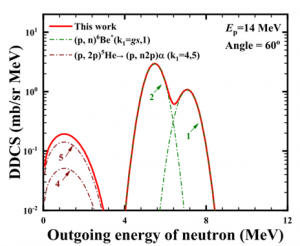Laying the foundation for unlocking the secrets of stellar reactions: breakthrough in proton-lithium interactions
USA, May 7, 2024 /EINPresswire.com/ -- Researchers have developed a comprehensive statistical theory for analyzing the proton-induced Lithium-6 (Li) reaction, significantly enhancing our understanding of light nucleus reactions. This breakthrough promises to refine nuclear data critical for various scientific and technological applications, including neutron sources and astrophysical studies.
The reactions between protons and Lithium isotopes, especially Lithium-6, are pivotal for several domains ranging from nuclear energy applications to astrophysics. The detailed understanding of these interactions aids in improving models for neutron generation and sheds light on cosmic nucleosynthesis processes. Traditional models have struggled to accurately describe these complex interactions, particularly due to the specific characteristics and reactions of Lithium-6.
A recently study (https://doi.org/10.1007/s41365-024-01421-5) published in the journal of Nuclear Science and Techniques, has been developed the Statistical Theory of Light Nucleus Reaction (STLN) model, focusing on the double-differential cross-sections of outgoing particles from proton-induced Lithium-6 reactions.
Centered on the pioneering STLN model, this research introduces a groundbreaking method for deciphering proton-induced reactions in Lithium-6. Uniquely, the STLN model weaves together the core principles of energy, angular momentum, and parity conservation, which are critical in steering the behavior of particles during nuclear reactions. Through detailed calculations of proton interactions with Lithium-6 nuclei, the model adeptly forecasts the release of diverse particles, such as neutrons, protons, deuterons, 3He, and alpha. These forecasts are pivotal for predicting the outcomes of nuclear reactions, which have broad implications ranging from the generation of advanced neutron sources to enhancing our understanding of elemental formation in stars. In contrast to previous frameworks, the STLN model emphasizes the conservation of energy, angular momentum, and parity both for neutron and proton induced light nucleus reactions, thus offering more profound insights into the mechanics of reactions. It meticulously delineates the dynamics and consequences of proton engagements with Lithium-6, encapsulating both the orderly and concurrent release of neutrons and light charged particles.
Dr. Xiao-Jun Sun, the lead researcher, stated, "Our statistical theory model, enhanced by the unified Hauser-Feshbach and exciton model, marks a significant leap forward. It not only aligns well with experimental data but also opens new avenues for understanding the intricate dynamics of light nucleus reactions."
What makes this research a landmark is its ability to accurately align theoretical predictions with experimental data, showcasing the dynamics of light nucleus reactions with unprecedented clarity. This not only resolves long-standing discrepancies in nuclear physics but also provides a reliable computational tool for exploring nuclear reactions, thereby opening new frontiers in our quest to understand the universe's elemental makeup and the processes powering stars.
DOI
10.1007/s41365-024-01421-5
Original Source URL
https://doi.org/10.1007/s41365-024-01421-5
Funding information
This work was supported by the National Natural Science Foundation of China (No. 12065003), the Guangxi Key R&D Project (2023AB07029), the Scientific Research and Technology Development Project of Guilin (20210104-2), and the Central Government Guides Local Scientific and Technological Development Funds of China (Guike ZY22096024).
Lucy Wang
BioDesign Research
email us here
Legal Disclaimer:
EIN Presswire provides this news content "as is" without warranty of any kind. We do not accept any responsibility or liability for the accuracy, content, images, videos, licenses, completeness, legality, or reliability of the information contained in this article. If you have any complaints or copyright issues related to this article, kindly contact the author above.

